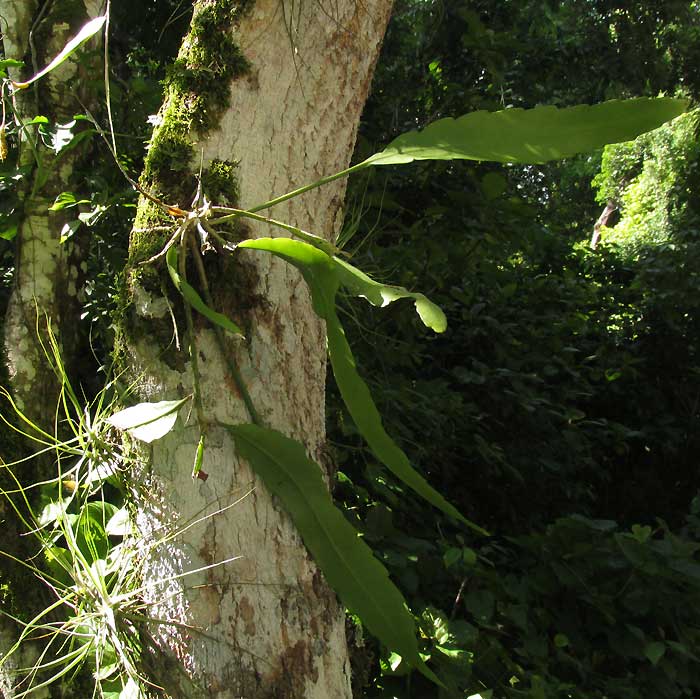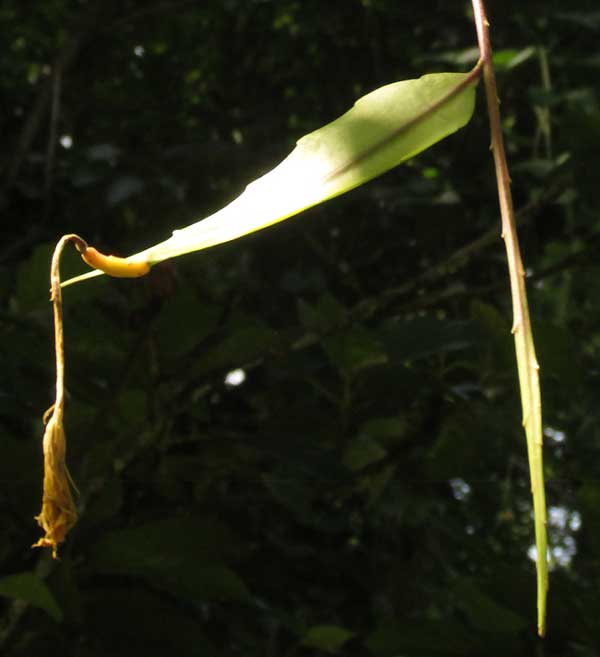Excerpts from Jim Conrad's
Naturalist Newsletter
from the February 1, 2019 Newsletter with notes from an October, 2018 camping trip into Chiapas, the southernmost state of MÉXICO
GUATEMALAN CLIMBING CACTUS, IN CHIAPAS
Last October 5th, during my camping trip into Chiapas, climbing on a tree trunk beside the entry road to the ruins in Palenque National Park, a cactus issued flat, tongue-shaped blades with crenelated margins but no spines or tiny, spinelike "glochids," as shown below:

Apparently the flowering season had just passed, for two or three blades bore the limp remains of corollas atop ovaries just starting to enlarge into fruits, as seen below:

In that picture the collapsed corolla dangles at the left. It arises from the tip of a yellowish, enlarging, fingerlike ovary, which will mature into an oblong, red, juicy fruit. An important detail to notice on the limp corolla is that what once was its slender tube is much longer than the mop of decomposing corolla lobes or petals, at the bottom.
Also in that picture the narrow, downward-pointing item at the right is an immature blade just beginning to widen, and still in the process of growing longer. Notice how it arises from a stiff, purplish, rounded stem. These stems can be fairly long, with flat blades arising intermittently along them. Below, you can see a cluster of such drooping, blade-bearing stems, with our blossom-bearing blade visible in the picture's lower, right corner:

Only a few cactus genera produce such flat, spineless blades on similarly long stems, and of the few that share these field marks, an important feature for determining the genus is the flower. Our wilted flower with what remains of its exceptionally slender, long corolla tube and shorter petals leads us right to the cactus genus Epiphyllum, of which 19 species are known. The name Epiphyllum celebrates the genus's peculiarity of producing flowers on the leaf -- the Greek epi, for upon, and phyllon, a leaf. Flowers upon the leaf.
Actually, such cactus blades are not leaves but rather stem segments modified to function as leaves, known as "phylloclades." But taking that into consideration, we wouldn't get such a neat name as Epiphyllum. Species of Epiphyllum often are known as climbing cacti, though several other genera also produce tree-living (epiphytic) species and go by that name.
Three or four Epiphyllum species are listed for Chiapas. Based on the size, shape and distance apart of the blade margins' scallops, or crenations, and the plant's habitat, this must be EPIPHYLLUM GUATEMALENSE*, distributed from southern Mexico south through Guatemala into Honduras. I've not seen an English name for the cactus but with a species name like guatemalense, what can we call it but Guatemalan Climbing Cactus?
By the way, Epiphyllum guatemalense is the name used at the CactiGuide.Com website, with Epiphyllum phyllanthus being listed as a synonym. The online Flora of North America treats the names just the opposite, with Epiphyllum guatemalense being the synonym of Epiphyllum phyllanthus.
Little information about the species is available on the Internet, except for this: Many pages sell as a curiosity an odd-looking, twisted cultivar of the species, probably a mutation, under a variety of made-up names, Curly-locks Cactus being one of them. You can such a specimen at the GardeningKnowhow.Com website.